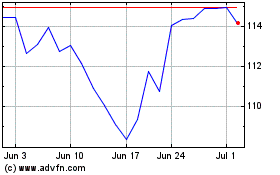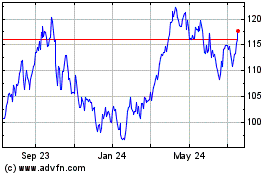By Rob Taylor and Rachel Pannett
When Papua New Guinea joined the ranks of the world's
significant energy exporters four years ago, the government was
betting on a revenue windfall it hoped would transform the
impoverished South Pacific nation better-known for jungles,
violence and corruption.
But the payday from a $19 billion Exxon Mobil Corp.-led
natural-gas project has so far been a trickle, crimped by a
downturn in gas prices that allowed Exxon and its partners to claim
losses against royalty payments. A 7.5-magnitude earthquake in
February that killed more than 100 people and left 300,000 homeless
further strained government resources.
To bridge the revenue gap and revive its slowing economy, Papua
New Guinea has increasingly turned to China. The government now
owes the state-owned Export-Import Bank of China close to $1.9
billion in low-cost loans for infrastructure and other construction
projects, almost a quarter of its total debt. That has raised
concerns the country's growing indebtedness is allowing Beijing to
further expand its influence in the Pacific.
China's stamp on Papua New Guinea will be on show in November
when Pacific Rim leaders, including President Trump and China's
President Xi Jinping, gather in the capital, Port Moresby.
Delegates attending the Asia-Pacific Economic Cooperation forum
will meet in a convention center built by Chinese workers and paid
for with a Chinese grant. Official motorcades will travel on a
six-lane boulevard constructed and financed by Chinese loans.
"We took on APEC knowing it would be a massive challenge for
such a small country," said Charles Abel, Papua New Guinea's
treasurer and deputy prime minister. "It is a bold undertaking by
our small country to introduce ourselves to the world."
A former Australian colony of eight million, Papua New Guinea
has long relied on foreign aid. The country has minimal
infrastructure outside Port Moresby and companies typically
negotiate terms with local landowners to gain access to resources
-- a knotty problem in a country with hundreds of ethnic
groups.
The government has historically looked to Australia for
assistance. The country, along with other APEC members, is also
chipping in for the summit, covering about a third of the cost.
Australia's foreign minister, Julie Bishop, said the country wants
to be the "natural partner of choice" for Papua New Guinea and
other Pacific countries.
But China's presence is becoming much more visible. Chinese
loans have helped redevelop a port and airport in the second
largest city, Lae. In November, China promised to build $3.5
billion of roads, a commitment that if realized would make it the
country's biggest aid donor, according to the Sydney-based Lowy
Institute's Pacific program. It also imports natural gas from Papua
New Guinea and has invested in nickel mines, power stations and
other projects.
During a visit by Prime Minister Peter O'Neill to Beijing in
June, Papua New Guinea became the first Pacific country to sign up
to China's One Belt One Road, an initiative to build a global
network of ports, railways, roads and pipelines. For Beijing, the
program is a way to expand business and trade and extend strategic
influence, in part by distributing loans.
Mr. Xi said during the visit that relations between the two
countries had "entered a fast track, and political mutual trust and
mutually beneficial cooperation have both reached a new level in
history." In July, Mr. O'Neill invited Pacific leaders to a meeting
with Mr. Xi in Papua New Guinea ahead of APEC.
But China's infrastructure push in the region has raised some
alarms. A Chinese-financed building spree in Pakistan has been
dogged by concerns about the country's growing debt burden to
Beijing. Sri Lanka's government, unable to repay a Chinese loan for
a port, last year granted a Chinese state company a 99-year lease
on the facility.
The International Monetary Fund said Pacific nations including
Tonga, Samoa and Vanuatu have significant debts to China and face
repayment pressures. Papua New Guinea is no exception.
"The speed and scale with which China is acquiring natural
resources and amassing debt raise long-term concerns,"
foreign-policy scholars Gabrielle Chefitz and Sam Parker wrote in a
May paper for Harvard Kennedy School's Belfer Center for Science
and International Affairs.
Standard & Poor's in April lowered Papua New Guinea's credit
rating to B from B-plus, citing slower economic growth and
expanding government deficits. It expects the ratio of government
debt to gross domestic product to reach 40% by 2021 from 30%
now.
Papua New Guinea's Treasurer, Mr. Abel, said he has been closely
following the loans offered by China to small Pacific nations.
"There remains some concerns about the way that they do conduct
business," he said. "But in PNG's case, we quite strictly manage
our debt."
China's Ministry of Foreign Affairs said its assistance to Papua
New Guinea and other Pacific Island nations has been welcomed by
their governments. "China has provided assistance, especially
assistance without any political conditions, to the Pacific Island
nations, including Papua New Guinea," the ministry said. "It is not
targeting on any third party.
Mr. Abel, speaking of the Exxon-led gas project, conceded that
for the hundreds of millions the government paid for its stake --
through a state-owned oil company -- "we have not had the
corresponding revenue growth."
Before production began in 2014, the country's Treasury
department estimated the project would boost government revenue by
roughly $600 million, or two billion Kina, a year through 2021,
rising to more than $1 billion, or 3.5 billion Kina, a year between
2022 and 2030. Instead, as of September 2017, roughly $45 million
in royalties and development levies had been paid, according to the
IMF.
"When commodity prices are depressed like they have been for the
last few years, revenues to all joint venture participants,
including government, are reduced," Exxon said in a statement.
The shortfall has weighed on the commodity-dependent economy.
The IMF in a December report estimated GDP grew 2.2% in 2017, down
from 2.4% in 2016, far below the government's predictions a few
years ago that the country would grow 21%.
--Chunying Zhang contributed to this article.
Write to Rob Taylor at rob.taylor@wsj.com and Rachel Pannett at
rachel.pannett@wsj.com
(END) Dow Jones Newswires
August 11, 2018 10:14 ET (14:14 GMT)
Copyright (c) 2018 Dow Jones & Company, Inc.
Exxon Mobil (NYSE:XOM)
Historical Stock Chart
From Mar 2024 to Apr 2024

Exxon Mobil (NYSE:XOM)
Historical Stock Chart
From Apr 2023 to Apr 2024
